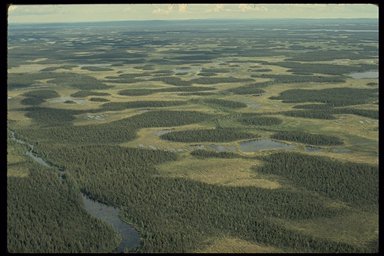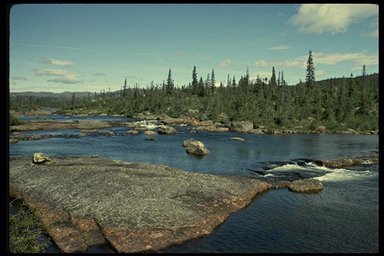
SEA OF SPRUCE
"The land should not be called the New land, being composed of stones and
horrible rugged rocks...I am rather inclined to believe that this is the land god
gave to Cain".
Jacques Cartier, 1534.
THE LAND:
This is the easternmost extension of the Canadian Shield. Along the southern edge of the region, the coastline resembles the edge of an unfinished jigsaw puzzle, with bold, jutting headlands, bays and a frieze of islands. From the Strait of Belle Isle, the land rises abruptly 200-400 metres to forested slopes dissected by swift rivers. Inland is a rolling plateau strewn with bogs and amoeboid lakes woven together by a tracery of rivers full of rapids. Meandering eskers and lines of boulders crisscross the plateau.

The cold Labrador Current brings Arctic waters, chilling the land. Icebergs are often seen along the coast, earning it the nickname "Iceberg Alley". Fog is frequent, and intense storms regularly buffet this region.
Several interesting historical sites are found in this area. At Red Bay, site of a Basque whaling station in the fifteenth century, the oldest shipwreck north of the Caribbean has been uncovered along with numerous artifacts.

The vegetation of this region is a continuous transition from boreal forest to arctic tundra. Along the exposed southeastern coast and interior uplands, the vegetation is similar to areas much further north - open stands of stunted black spruce with an understory of dwarf birch, Labrador tea, lichen and moss. Many large treeless areas exist.
Around Lake Melville, a huge inland water body, magnificent stands of black spruce and balsam fir with an understory of feathermoss are common. This "high boreal" forest is valuable for wood pulp. The slow growth of the trees results in a denser fibre content and thus more wood pulp per unit volume than can be obtained from larger trees grown in more moderate climates.
WILDLIFE:
Wildlife characteristic of the boreal forest thrives here: moose, caribou, black bear, red fox, lynx, snowshoe hare, wolf, spruce grouse, raven. Along the coast congregate seabirds and waterfowl: Atlantic puffins, murres, petrels, gannets, Canada geese, eider ducks, and black ducks, among others. Seals, whales and the occasional polar bear frequent the coast.
STATUS OF NATIONAL PARKS:
No national parks have yet been established in this region. Interest in a national park in the Mealy Mountains area dates back to the early 1970s, when research identified it as a natural area of Canadian significance. Public consultations in the late 1970s concluded that, although there was strong public interest in a national park, further discussions should be put on hold until Aboriginal people could deal with the park proposal in the context of land claims negotiations. Recent activity concerning the Innu Nation claim is promising.
The Mealy Mountains rise steeply out of tidal Lake Melville, reaching heights of over 1200 metres. The highest peaks are snowcapped throughout most of the summer. In the mountains tree cover is sparse and the area stands out as a large island of arctic tundra. The largest herd of barren-ground caribou in the region frequents the proposed park area.
Establishment of a national park in this natural region would be done in partnership with the Government of Newfoundland and Labrador and the Innu Nation.
The following table summarizes the status of system planning for each step toward establishing a new national park in this natural region.
| Steps in the Park Establishment Process. | Status |
| Representative Natural Areas Identified: | done |
| Potential Park Area Selected: | done |
| Park Feasibility Assessed: | 0 |
| Park Agreement Signed | 0 |
| Scheduled Under the National Parks Act : | 0 |